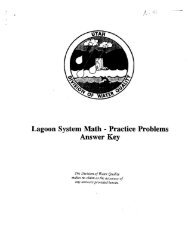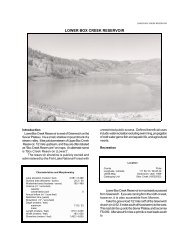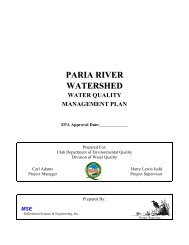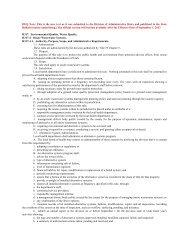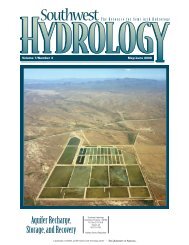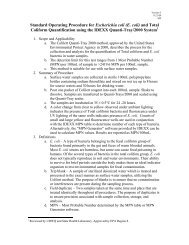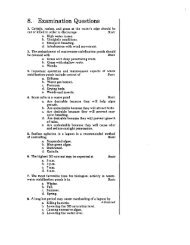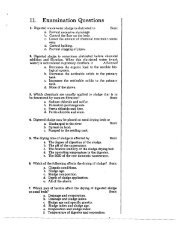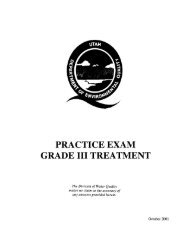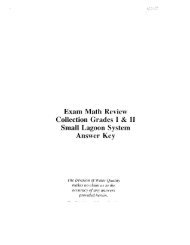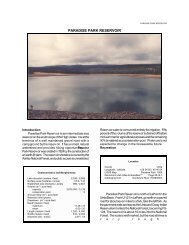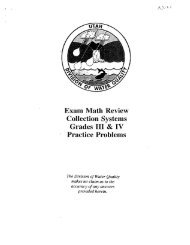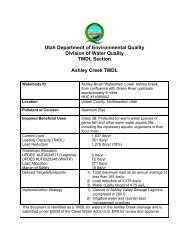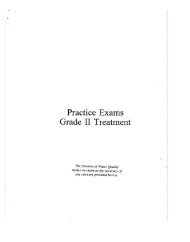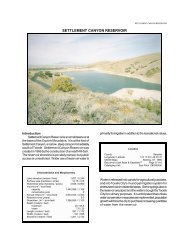BIRCH CREEK RESERVOIR #2 - Division of Water Quality
BIRCH CREEK RESERVOIR #2 - Division of Water Quality
BIRCH CREEK RESERVOIR #2 - Division of Water Quality
Create successful ePaper yourself
Turn your PDF publications into a flip-book with our unique Google optimized e-Paper software.
LAKE REPORTS<br />
D o C pH DO<br />
Cond<br />
0 19.7 8.5 7.5 332<br />
1 19.2 8.5 7.5 331<br />
2 19.1 8.5 7.5 331<br />
3 19.1 8.5 7.5 332<br />
4 19.1 8.5 7.6 332<br />
5 19.1 8.5 7.6 332<br />
6 18.6 8.4 6.0 339<br />
7 18.4 8.3 5.1 343<br />
8 18.1 8.1 3.0 350<br />
9 17.9 7.9 1.3 358<br />
10 17.7 7.8 1.2 362<br />
11 17.4 7.8 1.1 371<br />
12 16.7 7.6 1.1 386<br />
along the reservoir shoreline.<br />
There are no point sources <strong>of</strong> pollution in the<br />
watershed.<br />
Beneficial Use Classification<br />
The state beneficial use classifications include:<br />
boating and similar recreation (excluding swimming) (2B),<br />
cold water game fish and organisms in their food chain<br />
(3A) and agricultural uses (4).<br />
Temp<br />
DO<br />
Information<br />
a significant loss <strong>of</strong> dissolved oxygen downward in the<br />
water column. The dissolved oxygen concentration falls<br />
below the standard for a cold water fishery (6.5 mg/L) at 6<br />
meters. Below 8 the concentration <strong>of</strong> dissolved oxygen<br />
approaches an anoxic state. According to DWR stocking<br />
records Birch Creek Reservoir <strong>#2</strong> has been stocked with<br />
30,000 fingerling rainbow trout (Oncorhynchus<br />
mykiss) annually. In addition some cutthroat trout<br />
(Oncorhynchus clarki) are present in the reservoir.<br />
Emergent macrophytes are very limited in the reservoir.<br />
The reservoir has not been chemically treated by the<br />
DWR, so populations <strong>of</strong> native fishes could still be present<br />
in the reservoir<br />
Phytoplankton in the euphotic zone include the<br />
following taxa (in order <strong>of</strong> dominance)<br />
Management Agencies<br />
Bear River Association <strong>of</strong> Governments 752-7242<br />
<strong>Division</strong> <strong>of</strong> Wildlife Resources 538-4700<br />
<strong>Division</strong> <strong>of</strong> <strong>Water</strong> <strong>Quality</strong> 538-6146<br />
Bureau <strong>of</strong> Land Management 539-4001<br />
Bear River Resource Area 977-4300<br />
Recreation<br />
Bridgerland Travel Region (Logan) 657-5353<br />
Garden City Chamber <strong>of</strong> Commerce 946-2901<br />
Reservoir Administrators<br />
Wes Tingey 793-4229<br />
Woodruff Reservoir and Irrigation Company<br />
PO Box 520, Woodruff, UT 84086<br />
Species<br />
Cell Volume% Density<br />
(mm 3 /liter) By Volume<br />
Aphanizomenon flos-aquae 11. 092<br />
80.46<br />
Sphaerocystis schroeteri2.641 19.16<br />
Oocystis borgei 0.022 0.16<br />
Wislouchiella planktonica 0. 020<br />
0.15<br />
Pennate diatoms 0.010 0.07<br />
Total 13.785<br />
Shannon-Weaver [H'] 0.52<br />
Species Evenness 0.32<br />
Species Richness 0.17<br />
As observed, the reservoir is predominately populated by<br />
blue-green algae indicative <strong>of</strong> eutrophic conditions.<br />
Pollution Assessment<br />
Nonpoint pollution sources include the following:<br />
Sedimentation and nutrient loading from grazing, and litter,<br />
human waste and chemicals from recreation.<br />
Grazing takes place throughout the watershed and



